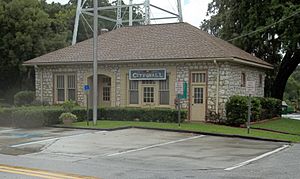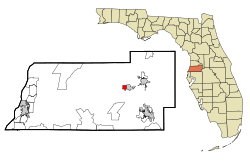San Antonio, Florida facts for kids
Quick facts for kids
San Antonio, Florida
|
|
|---|---|
| City of San Antonio | |

San Antonio City Hall (built 1939)
|
|
| Nickname(s):
San Ann, San An'
|
|
| Motto(s):
"Gem of the Highlands"
|
|

Location in Pasco County and the state of Florida
|
|
| Country | |
| State | |
| County | Pasco |
| Settled (San Antonio de Padua) |
February 15, 1882 |
| Incorporated (Town of San Antonio) | August 7, 1891 |
| Incorporated (City of Lake Jovita) |
June 2, 1926 |
| Incorporated (City of San Antonio) |
May 23, 1931 |
| Government | |
| • Type | Mayor-Commission fused |
| Area | |
| • Total | 1.36 sq mi (3.52 km2) |
| • Land | 1.36 sq mi (3.52 km2) |
| • Water | 0.00 sq mi (0.00 km2) |
| Elevation | 167ft/469ft ft (51/201 m) |
| Population
(2020)
|
|
| • Total | 1,297 |
| • Density | 954.38/sq mi (368.44/km2) |
| Time zone | UTC-5 (Eastern (EST)) |
| • Summer (DST) | UTC-4 (EDT) |
| ZIP code |
33576
|
| Area code(s) | 352 |
| FIPS code | 12-63375 |
| GNIS feature ID | 0290470 |
San Antonio is a small city in Pasco County, Florida, in the United States. Locals sometimes call it "San Ann" or "San An". It is part of the larger Tampa Bay Area, which includes cities like Tampa and St. Petersburg. In 2020, about 1,297 people lived there.
The city was started as a Catholic community by Judge Edmund F. Dunne. It is named after Saint Anthony of Padua. Saint Leo University is also located very close to San Antonio.
Contents
History of San Antonio, Florida
San Antonio was first planned in 1881 by Edmund F. Dunne. He used to be a chief judge in the Arizona territory. Dunne received a large piece of land in Florida as payment for his work on a big land deal.
On February 15, 1882, Judge Dunne chose the exact spot for the city. He wanted to create a Catholic community in Florida. He also planned other small villages nearby, but only Saint Joseph still exists today.
In 1889, a group of Benedictines (a type of Catholic religious order) started a monastery called St. Leo and a school called St. Leo College. These were built on land that used to belong to Judge Dunne. This area later became the separate town of St. Leo, Florida.
Around the same time, five Benedictine sisters started Holy Name Convent in San Antonio. They taught at local schools. In 1911, the nuns moved their convent and a school called Holy Name Academy to St. Leo. They continued to teach at St. Anthony School in San Antonio until 2010.
When San Antonio was founded, it was part of Hernando County. Pasco County was not created until 1887. The Orange Belt Railway started train service to San Antonio in November 1887. For a short time in the 1920s, San Antonio was officially called Lake Jovita, but it changed back to San Antonio before the end of that decade.
Geography and Location
San Antonio is located at 28°20′12″N 82°16′30″W / 28.33667°N 82.27500°W.
The United States Census Bureau says that the city covers about 1.2 square miles (3.52 square kilometers) of land. There is no water within the city limits.
Climate and Weather
The weather in San Antonio is known for its hot and humid summers. The winters are generally mild. This type of weather is called a humid subtropical climate.
Population and Demographics
This section shows how the population of San Antonio has changed over the years.
| Historical population | |||
|---|---|---|---|
| Census | Pop. | %± | |
| 1910 | 131 | — | |
| 1920 | 262 | 100.0% | |
| 1930 | 322 | 22.9% | |
| 1940 | 267 | −17.1% | |
| 1950 | 286 | 7.1% | |
| 1960 | 479 | 67.5% | |
| 1970 | 473 | −1.3% | |
| 1980 | 529 | 11.8% | |
| 1990 | 776 | 46.7% | |
| 2000 | 655 | −15.6% | |
| 2010 | 1,138 | 73.7% | |
| 2020 | 1,297 | 14.0% | |
| U.S. Decennial Census | |||
Population by Race and Ethnicity
The tables below show the different groups of people living in San Antonio based on the 2010 and 2020 United States censuses.
| Race | Pop 2010 | Pop 2020 | % 2010 | % 2020 |
|---|---|---|---|---|
| White (NH) | 1,043 | 994 | 91.65% | 76.64% |
| Black or African American (NH) | 12 | 32 | 1.05% | 2.47% |
| Native American or Alaska Native (NH) | 0 | 11 | 0.00% | 0.85% |
| Asian (NH) | 4 | 17 | 0.35% | 1.31% |
| Pacific Islander or Native Hawaiian (NH) | 0 | 0 | 0.00% | 0.00% |
| Some other race (NH) | 3 | 3 | 0.26% | 0.23% |
| Two or more races/Multiracial (NH) | 7 | 54 | 0.62% | 4.16% |
| Hispanic or Latino (any race) | 69 | 186 | 6.06% | 14.34% |
| Total | 1,138 | 1,297 |
In 2020, there were 1,297 people living in San Antonio. These people lived in 447 households, and 342 of those were families.
In 2010, there were 1,138 people, 414 households, and 302 families in the city.
Schools and Education
San Antonio has two schools.
- Saint Anthony Catholic School (for students from Pre-Kindergarten to 8th grade) started in 1883. It is the oldest school in Pasco County.
- San Antonio Elementary School (for students from Kindergarten to 5th grade) opened in 1981. Even though it's in San Antonio, its mailing address is Dade City, Florida.
Holy Name Academy was an all-girls boarding school started in 1889. It moved to the nearby town of St. Leo in 1911.
Notable People
- Chris Arnade is a writer and photographer who grew up in San Antonio. He used to work on Wall Street.
Images for kids
See also
 In Spanish: San Antonio (Florida) para niños
In Spanish: San Antonio (Florida) para niños



